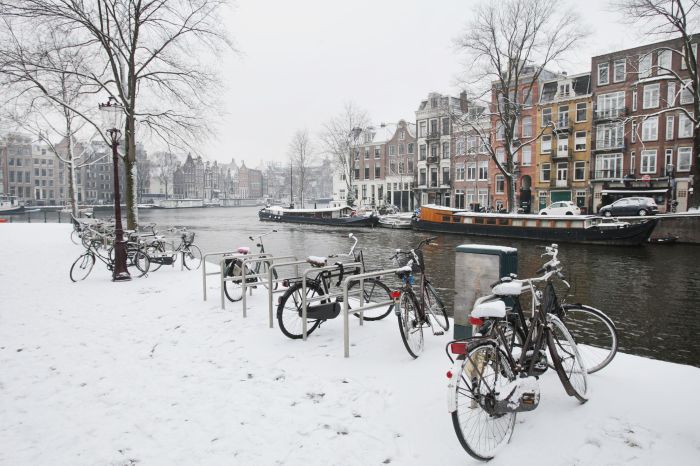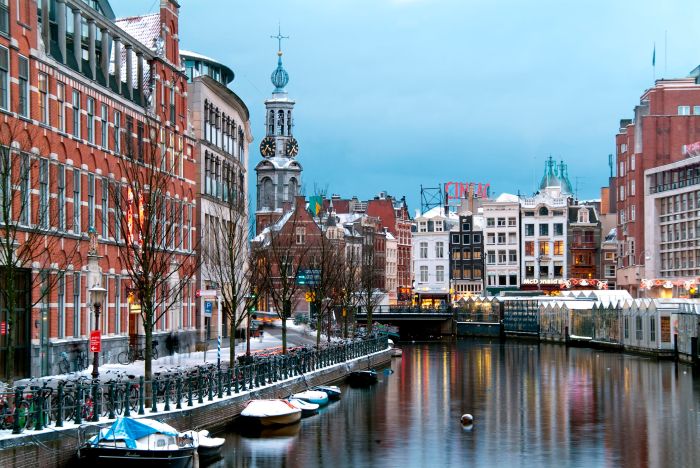Delve into the captivating realm of Amsterdam weather, where temperate breezes dance with maritime influences, shaping a climate that is both mild and alluring. Amsterdam’s weather, with its gentle temperatures, abundant humidity, and frequent showers, paints a vibrant tapestry that adds to the city’s charm.
Throughout the seasons, Amsterdam’s weather transforms, offering a kaleidoscope of conditions. From the crisp embrace of winter to the balmy caress of summer, each month brings its own unique meteorological symphony.
Overview of Amsterdam’s Climate

Amsterdam’s climate is generally temperate and is influenced by its proximity to the North Sea. The city experiences mild temperatures throughout the year, with average highs in the summer months reaching around 20°C (68°F) and average lows in the winter months dropping to around 2°C (36°F).
Amsterdam’s climate is characterized by high humidity and frequent precipitation. The city receives an average of 800 mm (31.5 in) of rainfall per year, which is spread fairly evenly throughout the year. The city also experiences frequent fog and mist, particularly during the winter months.
Historical Overview
Amsterdam’s climate has changed over time, with the city becoming slightly warmer and wetter in recent decades. This is likely due to the effects of climate change, which is causing global temperatures to rise and precipitation patterns to change.
Despite Amsterdam’s unpredictable weather, one can still appreciate its charm. From sunny days to drizzles, the city remains vibrant. However, if you seek a more extreme weather experience, consider Aconcagua , the highest peak outside Asia. Its icy slopes and unpredictable storms offer a thrilling adventure for mountaineers.
Upon returning to Amsterdam, the milder weather may feel like a warm embrace, making you appreciate the city’s unique weather patterns all the more.
Seasonal Weather Patterns

Amsterdam’s weather patterns exhibit distinct variations throughout the year, influenced by its location in northwestern Europe and the North Sea’s proximity. The city experiences four distinct seasons, each characterized by unique weather conditions.
Spring
Spring in Amsterdam (March to May) is a period of transition, marked by gradually warming temperatures and increasing sunshine. Average temperatures range from 7°C to 15°C (45°F to 59°F), with occasional showers and the occasional thunderstorm. As the season progresses, the days become longer and brighter, with flowers blooming in parks and gardens.
The weather in Amsterdam can be unpredictable, with frequent showers and occasional sunshine. If you’re looking for a more reliable climate, consider visiting Antigua Guatemala , a beautiful colonial city with a pleasant year-round temperature. While the weather in Amsterdam may be unpredictable, its charm and beauty are undeniable.
With its picturesque canals, historic buildings, and vibrant nightlife, Amsterdam is a city that will capture your heart.
Summer
Summer in Amsterdam (June to August) is typically warm and pleasant, with average temperatures ranging from 16°C to 22°C (61°F to 72°F). The days are long, with up to 16 hours of daylight, and the evenings are often mild and balmy. Occasional showers or thunderstorms can occur, but the overall weather is generally favorable for outdoor activities.
Autumn
Autumn in Amsterdam (September to November) brings a gradual decline in temperatures and an increase in precipitation. Average temperatures range from 12°C to 18°C (54°F to 64°F), with frequent showers and occasional windy days. The leaves on the trees change color, creating a vibrant and picturesque landscape.
Winter
Winter in Amsterdam (December to February) is generally mild compared to other European cities at similar latitudes. Average temperatures hover around 4°C (39°F), with occasional dips below freezing. Snowfall is infrequent, but when it does occur, it usually melts quickly. The days are short, with only about 8 hours of daylight, and the evenings can be cold and damp.
The weather in Amsterdam can be unpredictable, so it’s always a good idea to pack for all types of weather. If you’re looking to reduce your environmental impact while traveling, consider checking out eco-friendly travel tips. From choosing sustainable transportation options to packing light, there are many ways to travel more responsibly.
And when the sun does come out, be sure to take advantage of Amsterdam’s many outdoor activities, like biking through the city’s canals or visiting one of its many parks.
Temperature and Precipitation
Amsterdam experiences a temperate oceanic climate, characterized by mild temperatures and relatively high humidity throughout the year. The city’s proximity to the North Sea has a significant influence on its weather patterns, resulting in frequent precipitation and moderate temperature fluctuations.
Monthly Distribution of Temperature and Precipitation
The following table illustrates the average monthly temperature and precipitation levels in Amsterdam:
| Month | Average Temperature (°C) | Average Precipitation (mm) |
|---|---|---|
| January | 3.5 | 69.9 |
| February | 4.1 | 61.7 |
| March | 6.5 | 56.4 |
| April | 9.5 | 46.9 |
| May | 13.0 | 59.3 |
| June | 16.0 | 69.1 |
| July | 18.0 | 74.4 |
| August | 17.5 | 77.7 |
| September | 14.5 | 76.2 |
| October | 10.5 | 85.6 |
| November | 7.0 | 81.5 |
| December | 4.5 | 74.1 |
Factors Influencing Temperature and Precipitation
Several factors contribute to the temperature and precipitation patterns in Amsterdam:
- Location: Amsterdam’s location in northwestern Europe places it in the path of prevailing westerly winds, which carry moisture from the Atlantic Ocean.
- Proximity to the Sea: The city’s proximity to the North Sea moderates its temperature, preventing extreme heat or cold. The sea also contributes to the high humidity levels in Amsterdam.
- Prevailing Wind Patterns: The prevailing westerly winds bring frequent precipitation to Amsterdam, with more rain occurring in the fall and winter months.
Wind and Humidity

Wind patterns and humidity levels play significant roles in shaping Amsterdam’s weather and influencing the overall comfort of its residents and visitors.
The city experiences prevailing winds from the southwest, which bring in moist air from the North Sea. These winds are generally moderate in speed, averaging around 15-20 kilometers per hour (9-12 miles per hour) throughout the year. However, occasional strong gusts can occur, particularly during winter storms or thunderstorms.
Humidity
Amsterdam has a humid climate, with average relative humidity levels ranging from 70% to 85%. The high humidity levels are primarily due to the city’s proximity to the North Sea and the frequent presence of moist air masses.
During the summer months, high humidity can contribute to a muggy and uncomfortable feeling, especially during periods of high temperatures. Conversely, in winter, the high humidity can help to keep temperatures slightly warmer, reducing the severity of cold spells.
Climate Change and Its Impact

Climate change is a significant threat to Amsterdam’s weather and climate. Rising temperatures, changing precipitation patterns, and sea-level rise are all expected to have a significant impact on the city in the future.
Rising temperatures are likely to lead to more frequent and intense heat waves, which can be dangerous for human health. They can also lead to changes in precipitation patterns, with more intense rainfall and flooding events, as well as longer periods of drought.
Sea-Level Rise
Sea-level rise is another major threat to Amsterdam. The city is located in a low-lying area, and even a small rise in sea level could have a devastating impact. The city is already taking steps to protect itself from sea-level rise, including building sea walls and levees.
Mitigation Measures, Amsterdam weather
Amsterdam is taking a number of steps to mitigate the effects of climate change. These include:
- Investing in renewable energy
- Improving energy efficiency
- Reducing greenhouse gas emissions
- Planting trees
- Educating the public about climate change
These measures are helping to reduce Amsterdam’s greenhouse gas emissions and prepare the city for the impacts of climate change.
Closure: Amsterdam Weather

As we conclude our exploration of Amsterdam’s weather, it is evident that this dynamic climate plays a vital role in shaping the city’s character. Whether you seek the cozy warmth of winter or the refreshing respite of summer, Amsterdam’s weather offers a captivating backdrop for your adventures.
Question & Answer Hub
What is the average temperature in Amsterdam?
The average temperature in Amsterdam is 11°C (52°F) throughout the year.
What is the average precipitation in Amsterdam?
Amsterdam receives an average of 850 mm (33.5 in) of precipitation per year.
What is the windiest month in Amsterdam?
January is the windiest month in Amsterdam, with an average wind speed of 20 km/h (12 mph).
What is the most humid month in Amsterdam?
August is the most humid month in Amsterdam, with an average relative humidity of 80%.